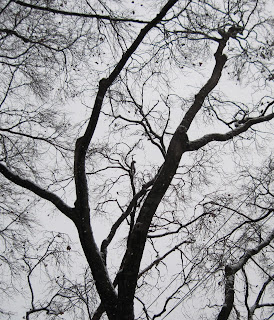When it began to snow for the first time of the winter season, I knew that they grey sky would make for an excellent picture to paint. I walked down the sidewalk until I found a tree that had an interesting shape. I loved the silhouette that the two main branches in the picture below create, against the smokey sky, and chose it for my painting. My only fear was that the branches might be overwhelmingly complicated. Ultimately I only picked the most visible branches, simplifying the picture. Firstly, I painted the grey sky, mixing different amounts of white and black depending on the section, and variations in brush strokes which are more visibly seen in person. Something I learned from this project was the use of water with acrylics. Typically I avoid water because it tends to strip the paint, but for the level of detail required it was necessary. I chose an extremely dark brown, wanting to avoid black as usual. I tried to capture the character of the tree, including lumpy branches, and sharp angles between smaller ones. Overall I am happy with the final product, and look forward to including trees in future work, perhaps ones with foliage.
Friday, January 18, 2013
Sunday, January 6, 2013
Edward Hopper Inspired Painting
After researching Edward Hopper and finding a lighthouse painting which particularly interested me, I went around my school's campus looking for some sort of architecture of similar nature that would be interesting to paint. On the Middle School, I found a very dramatic building face which, with the dark shadows and sun's glare, had an almost menacing quality to it. However, for aesthetic appeal, I enhanced the photos colors. From the beginning the sketch, I knew I wanted exact dimensions, therefore most lines were drawn or painted with rulers and tape. My first challenge for this painting was finding an appropriate shadow color to use throughout the piece. Thinking back to Hopper's use of dark-blue/gray on the lighthouse face, I mixed various colors until I came up with one that was neutral and versatile in that it was not overbearingly dark, but not noticeably bright. Admittedly in some regions it is more purple than others, but I left it as it was because of the additional dynamic it created. Next, I painted the large face with yellow, white, and the glare. I was worried that the gold haze surrounding the edges was too complicated and unnecessary, so I just focused on the color transition. Also, I chose a more vibrant green color for the sky and different sections. The final component was adding less-noticeable lines where rectangular shapes met, which I showed using a faint blue.


Green on Green Painting
 For this painting, we were instructed to take a picture of a green object on green paper, or some variation of this arrangement. My addition was the yellow sheet, which I chose because of its close relation to the other colors used. In the painting based on the photo, I tried to evaluate the different shades of green by using a photo with a great variety, ranging from a bright lime to a rich forest green. In front of the cup, I highlighted this brightness, and transitioned into a darker color behind the cup. One challenge I found doing this painting was the accurately portraying the elipse formed by the rim. The perfect ovular shape was difficult to capture, therefore at points there are indentations such as on the right side. On the other hand, I am very happy with how the inside walls and bottom of the cup turned out. I picked a yellow-brown color throughout the walls, adding green and yellow highlights in various parts. The transition from brown to orange and finally to yellow was done over a few days, and I learned the unanticipated lesson of fixing uneven surfaces created when thick paint layers dry. Next, to avoid showing the shadow of the cup as a dark mass, but rather one that revealed the colors beneath it, I did the base colors, then painted the individual sections of the shadow. Finally on the face of the cup, I tried to show the brown, green, and yellow lighting created.
For this painting, we were instructed to take a picture of a green object on green paper, or some variation of this arrangement. My addition was the yellow sheet, which I chose because of its close relation to the other colors used. In the painting based on the photo, I tried to evaluate the different shades of green by using a photo with a great variety, ranging from a bright lime to a rich forest green. In front of the cup, I highlighted this brightness, and transitioned into a darker color behind the cup. One challenge I found doing this painting was the accurately portraying the elipse formed by the rim. The perfect ovular shape was difficult to capture, therefore at points there are indentations such as on the right side. On the other hand, I am very happy with how the inside walls and bottom of the cup turned out. I picked a yellow-brown color throughout the walls, adding green and yellow highlights in various parts. The transition from brown to orange and finally to yellow was done over a few days, and I learned the unanticipated lesson of fixing uneven surfaces created when thick paint layers dry. Next, to avoid showing the shadow of the cup as a dark mass, but rather one that revealed the colors beneath it, I did the base colors, then painted the individual sections of the shadow. Finally on the face of the cup, I tried to show the brown, green, and yellow lighting created.
Subscribe to:
Comments (Atom)



